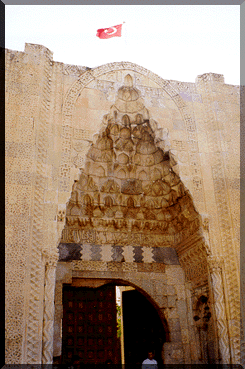A caravansary on the way from Konya to Aksaray 40 km / 25 mi before the city. It was built by Sultan Alaattin Keykubat I during the Seljuk period, in 1229. It has two sections, one open with a courtyard and another covered. It is the largest of all Seljuk caravansaries in Anatolia with an area of 4,800 sq m / 1.2 acres.
Sultanhan is a monumental caravansary which looks like a fortress. The entrance is through a huge, geometrically decorated portal. The courtyard is surrounded by an arcade of rooms on the left and covered places on the right. In the middle is a small mosque. The entrance to the second part is through another portal which is located on the fourth wall. The center of this second part is barrel-vaulted, containing cathedral-like aisles covered with a dome and capped by an octagonal conical roof.
These are public buildings built on the caravan routes for trade in normal times and for military use in times of emergencies. Because they were made to be utilized by the caravans, the distances between them were arranged according to the usual distance a camel could walk. A caravan could walk for about a day, and would not want to continue at night time. This meant that caravansaries were needed every 25-40 km / 15-26 mi.
The Anatolian Seljuks particularly understood the importance of trade and did a lot to encourage it. In these buildings they provided the caravans with every possible service such as places to sleep, hamams, mosques, doctors and veterinarians, kitchens, coffeehouses, libraries, etc. There were times in which any service was free of charge for the sake of active trade. For example, they even gave animals without charge to people who may have lost them.
The rulers of caravansaries were responsible for security. As a general rule they closed the gates at sunset and did not open them until sunrise unless they were sure that no belongings of people had been lost. According to the weather conditions, people sometimes had to share the covered section with animals. In such cases the smell of animals was lessened by using a variety of incenses.
Today there are approximately 120 caravansaries still standing in Anatolia.

 Portal of Sultanhan Caravansary,
13C AD, Seljuk period,Sultanhan
Portal of Sultanhan Caravansary,
13C AD, Seljuk period,Sultanhan